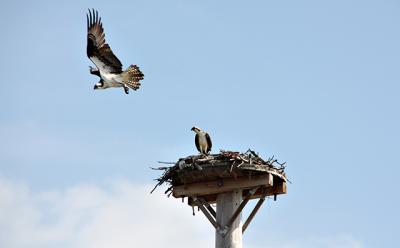Nature Notes: Ospreys Are Snickering

The fall is here, my favorite time of the year. The Hamptons are still the Hamptons, but the traffic is diminished, things slow down, the sky is beautiful, and the leaves turn myriad colors before they fall to the ground in November. It’s the time of the great bird migration and the harvesting of fish and shellfish, just like in the old days.
A week and a half ago three ospreys circled about 300 yards up over my house in Noyac, 100 feet off the bay. The uttered their “peet” notes, pausing after each, and circled and circled and circled slowly off to the west. I called back to them with the same whistled note that I have perfected over the years and they answered. In my mind they were saying, “Good-bye, see you next spring.” Isn’t it amazing that ospreys, like so many other of God’s creatures, have psyches of their own and perhaps even a world view, or as the Germans say, “weltanschauung.” Yes, they have to take care of the basics, i.e., satisfy the four basic drives — food, shelter, health, procreation — but these three ospreys were preoccupied with the wonderfulness of being able to make lazy circles in the sky under a full sun and on such a lovely day.
When it comes to shelter, wild birds find it under tree leaves or in nests, mammals, under trees or in holes, the human mammal in houses, condos, and apartments that have a very long history in the making. Human shelters in the Hamptons have become more than places to eat, sleep, and get out of the cold; they’ve become statements of wealth, standing, and traveling to and from them with ease.
Architects who design them and landscapers who wrap them in foliage would add the word “beauty.” In a way they are artists, and architecture is one of the great arts, along with painting, sculpting, ballet, symphonic music, and the rest of them. Around here they go up pretty fast and are in a large way responsible for the “trade parade” that greets each morn and says “so long” come later afternoon.
Having grown up in the Depression and during World War II, the house as a magnificent thing rather than a cozy place is beyond my ken. And what I have the hardest time understanding is why one house has to be razed to build another in its stead. My first 22 years on Long Island were spent on the North Fork. During the period, as well as I can remember and from listening to my parents, not a single dwelling was razed locally in order to build another.
Long before recycling became a modus operandi for the generation Xers and millennials, it was a way of life in Mattituck. Almost nothing was thrown out; almost everything was reused in one way or another. Yes, certain structures were rehabilitated and in that rehabilitation new materials replaced old ones, but the old ones, such as bricks, timbers, slates, pipes, etc., found their way to lots where they would await reuse. The one closest to home was the site of the North Fork Wrecking Company. As in the Arlo Guthrie song “Alice’s Restaurant,” you could get just about anything you needed there.
Tearing down houses and imploding buildings to construct new ones didn’t get started in a big way until the latter part of the 1900s. Now it’s a common
occurrence. One house in particular that strikes a chord is the one in which the late coastguardsman and fisherman Norman Edwards lived in on Atlantic Avenue in Amagansett only a block up from one of East Hampton Town’s his- toric districts. It was razed last year and replaced with a Farrellized edifice al- most instantaneously.
It was only 10 years old and served Norman and his wife, Lynda, well during that time and was a pretty house to drive by or visit. Then, poof, gone in an instant! And what of the stuff of which it was made?
Such is the way of the construction business, especially the second-home business, as practiced today. Granted, a few houses are moved off site and relo- cated before new ones takes their place, but only a few.
What a terrible waste! And at what a price to the aesthetics of the community and the congestion on the roads? When I lived in Oregon I was surrounded by Douglas firs, huge majestic trees 200 feet tall. Now the only Doug fir that I see are the boards and studs in the lumberyards and on their way to some second home, absent of branches, shaved clean and symmetrical, hardly a substi- tute for the real thing.
It’s one thing to cut down a living tree to mill into lumber. It’s another thing to throw the lumber away or bury it when you’re through with it. Wood can last a very long time. Europe is full of 1,000- year-old houses made mostly of wood, and we have several 300-year-old wood- en houses right here on Long Island, such the Mulford house in East Hampton and the Old House in Cutchogue on the North Fork.
So let’s get right down to it. We cut down more trees than we need to in order to feed the appetites of the well-to-do, thus leaving few trees to take up the carbon dioxide that is overheating the atmosphere and we call ourselves eco- logic and sustainable?
Maybe those circling ospreys were trying to tell me something has them “peeted” off. After all, they come back to the same abode year after year and as long as that abode works after a little rebuilding now and then they continue to use it throughout their lifetimes. Were they snickering?
